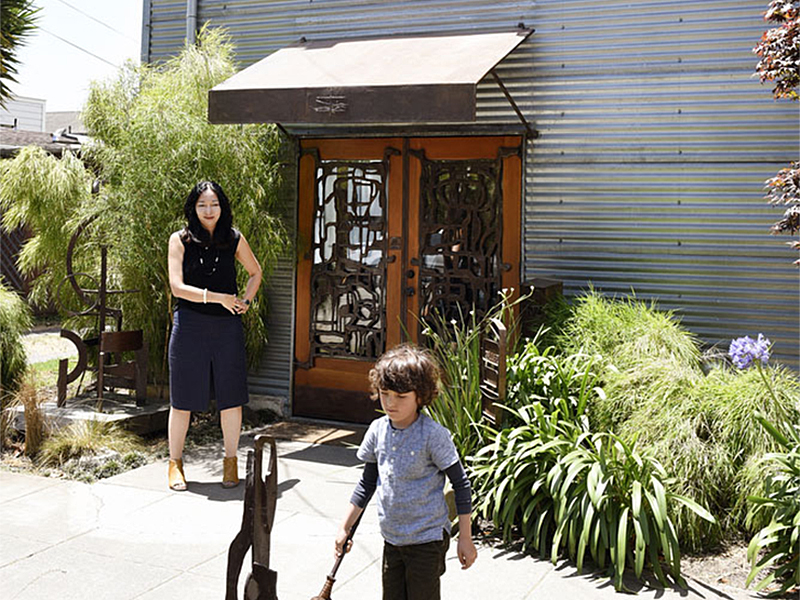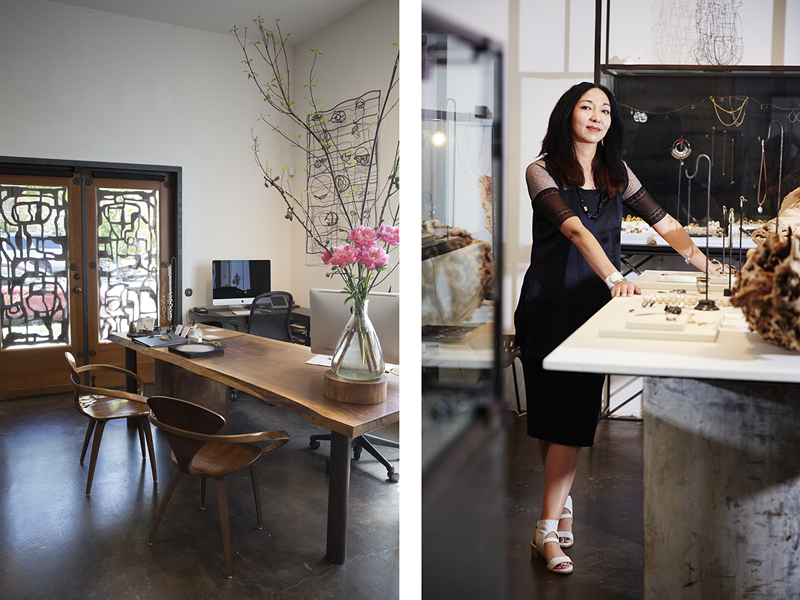
I have known April Higashi for many years and—full disclosure—she worked for me when I owned a gallery for a number of years. I think April is the ideal model for the new younger jewelers who find a way to make life work for them so they can support themselves in the world and still live a creative life. I am amazed by her talent and the creative attitude she has toward all aspects of her life. So I was delighted to be able to interview her. See what you think.
Susan Cummins: I know you have pursued many different projects in your career. Can you talk about a few of them and describe your educational background?
April Higashi: Lately I have been thinking a lot of my career path: where I’ve been and, now that I’m mid-career, where I’d like to end up. I’ve learned so much with each project I’ve undertaken along the way.
My educational background is in textiles, fashion, and fine art. I wasn’t satisfied with my education so I sought out experiences in the working world. It was these experiences that led me to jewelry making and eventually starting my own gallery.
I first started working in the fashion industry for both Nini Bambini and Esprit de Corp. One was a small company, the other a large corporation. I learned I wasn’t a corporate climber and preferred working on the big picture ideas rather than specializing.
When I was 25 and taking my first jewelry class at San Francisco City College, with Jack da Silva, I naively started my own jewelry business with a partner. While my business partner was good at getting her foot in the door to show our work, I discovered I was really good at problem solving. Our second order, for Banana Republic, was an order for 6,000+ pieces and required me to take all kinds of risks in order to figure out how to get it filled. I also discovered I had the courage to take on something like this, as well as new challenges.
When we closed the business it had over 300 accounts and had supported us for more than six years.
While I loved working at the bench, I was not the sort of jeweler who could spend every day there. So I always pursued other part-time work until I started Shibumi Gallery.
These work experiences were essential to my education.
From 2001 to 2004, I taught at CCAC and learned I was very good at editing and assessing people’s strengths and weaknesses. I also worked designing and creating displays for an LA showroom. This not only gave me great display practice but I also learned how to put different lines together. For a few years, I managed Lilith Clothing, which taught me I could assess what looked good on people and gain their confidence with honest feedback.
Later, I became art director for the Jerry Garcia Estate, which taught me how to manage a creative team.
I also worked for the enamel artist June Schwarcz, which deepened my artistic voice, and with you, at Susan Cummins Gallery, which I’ll discuss in greater detail below.
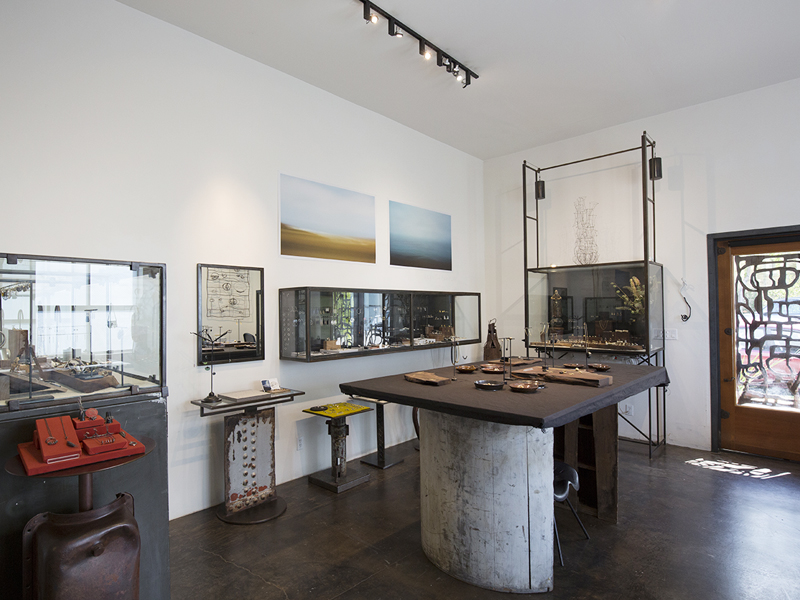
What inspired you to start a gallery? How long have you been doing it?
April Higashi: While working at the Susan Cummins Gallery in Mill Valley, I helped put together vignettes of jewelry and art for a show titled Jewelry and Objects. Something just clicked. I realized that, besides being at the bench, I loved putting diverse things together in creative and unexpected ways.
You, one of your artists, Dominic Di Mare, and June Schwarcz were all very complimentary of my aesthetic, and this validation gave me the encouragement and confidence to pursue my own personal vision.
I had continued making jewelry all along while I held these other jobs. When my art director position was ending, my now ex-husband and I found a live/work building that had a commercial space. I had been working on my jewelry for over 10 years and knew that it was time to do what I had come to realize I wanted to do—start a gallery. I had clientele that knew me. I had met many artists along the way.
My first show was a small group show, and within a month of opening, I was able to support myself. It seemed like a miracle. But I see now that all my diverse experiences had been preparing me to do this for years. The gallery is currently going on its twelfth year.

You are one among a large number of galleries internationally that have been founded by jewelers. I may be mistaken, but I don’t think that this occurs with any other art forms. Why do you think jewelers in particular have been so entrepreneurial?
April Higashi: That is a really good question. Why jewelers in general are entrepreneurial and why I personally am entrepreneurial may have two different answers.
In general, to get started in the jewelry world, many of us participate in gallery shows. So having one’s own gallery makes sense. Because jewelry is so personal, and often requires custom work or modifications, it can be easier to deal with clients directly. And it’s difficult to make it financially as a jeweler if you only do wholesale. Getting full retail for some work can make the difference between being profitable or not.
What led me, personally, to start a gallery was my love for displaying, and the enormous satisfaction I get when creating beautiful environments and connecting people with interesting pieces. And I’ve always been able to be both creative and pragmatic. I think that, mixed with being willing to take small risks and being honest and professional, has helped me earn the following and trust of my clients.
What advantage do you think being an artist gives you in the course of running a gallery? What are the challenges that come with being on both sides of the fence?
April Higashi: I know firsthand how much an artist is investing both time-wise and financially when they show at my gallery. When an artist is given a space to show, along with a deadline, their talent becomes focused and positive things happen.
I have created two jobs for myself, conceptualizing new work and curating shows, so time and prioritizing are my greatest challenges. I have to manage a team of eight, and finding good staff can be very challenging, especially in this economy. On top of that, I am the mother of a 6 ½-year-old, which comes with a whole set of other challenges.

Now that you are established and solidly a mid-career artist, how do you continue to challenge yourself?
April Higashi: When I think of ways to challenge myself, I always make sure it’s something I can take on while still keeping my life in balance. I try to pick one project that challenges me to learn something new or try something I have never done. This can be learning a technique or designing in a new metal. Currently the studio is learning to cast organic material. For the gallery, I am starting to think up designs for a beautiful new display case.
I think longer-term I’d love to find some sort of partner and conceive of an independent retail space. My live-work space has been great while being a mom and running a business, but I’d like to see how a space could maintain itself without having to be there all the time. I’m really interested in collaborating. I find bringing together creative ideas with interesting people very exciting. So that idea is in the incubator.
Please describe your space and the environment you live in.
April Higashi: My building is in West Berkeley, in an area with mixed-use zoning. There are artists, wineries, cement factories, beer brewers, and loud trains amongst residential housing. It’s a unique mix.
My building is a two-unit condo built with some of the ideas of barn architecture. The building has three floors. The bottom floor has a 500-square-foot space that is divided between the gallery, the studio, and a design workspace I share with my son. This area also doubles as an event and opening space. There are large double glass doors that open onto a huge backyard with bamboo and sculptures. I also have a guest room downstairs that I rent on occasion or use when artists come for a show.
I live upstairs with my son. It’s a large space with an open floor plan. There is a little room, formerly a deck, which we converted into my son’s bedroom. I have a small nest of a room upstairs which is my bedroom.
It’s a unique live/work space. I feel like each floor represents different parts of my life: work, live, sleep.
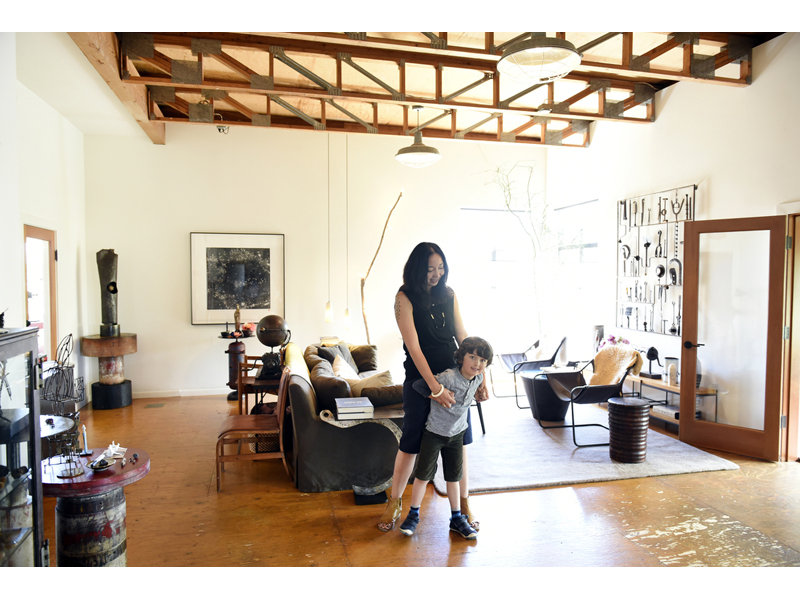
What does a typical day look like for you? How do you balance making your own work with selling the work of others in the gallery?
April Higashi: I’ve set up a schedule where I work full days Wednesday to Saturday. On Mondays I work a half-day with my bookkeeper and set up my team for the week. Then I pick up my son early to spend time together. Tuesday is my mental health day, which usually involves a run, and things like going to a museum. If it’s work related, it’s something fun like visiting a gallery or having lunch with an artist or client.
On the days I work full time at the gallery, I start by setting up my day with texts or emails to make sure my team knows the week’s priorities and everyone has what they need. I personally may go for a run, or out to coffee, and do some social media stuff. Then I head in and work on custom design, new pieces, special projects, and meeting clients. By 5:00 it’s time to pick up my son, so the day goes by quickly.
During a show and the weeks following it, the artist I’m showing becomes my priority. I contact clients who I think would connect with the artist’s work and make sure the work is given exposure whenever possible. I like to try to give each artist a nice check at the end of the show.
I love the way the gallery changes with each new show. It’s so much more dynamic than only showing my own work. I learn a lot from showing other artists, and I encourage my clients to mix different artist’s work. Clients seem to appreciate that.

How would you describe what you show? How do you select the artists you represent, and what does “representing” look like?
April Higashi: I like work that is well crafted; my artists have a background as makers, not only as designers. It feels like my taste navigates to organic but refined. I have a range of work that is made with alternative materials to fine jewelry. I have a base of artists I show regularly. But I reach out to new artists or when I see an artist’s work evolving in an interesting direction. I have only found one artist that I’ve shown through their soliciting me by email.
Also, I’ve started showing artists who don’t necessarily have work regularly in my gallery. I like the way it creates new interest and makes things fresh. Their work may be in the gallery for two to three months, and then you’ll never see it there, or have to follow the artist directly.
Who are the artists you have been successful showing?
April Higashi: By success, I’m guessing you mean sales. Last year I had a great show with Christina Odegard. She is so talented but doesn’t show with many people, so her work had not been seen much. I do well with Karen Gilbert, who is always evolving. Again, she doesn’t do many shows but uses her shows at my gallery to experiment with new ideas. Julia Turner’s work sells well. She is good at designing under a price point of $200 and uses a lot of discerning color in her work. I’ve also had great fine jewelry shows with Polly Wales and Jo Hayes Ward.
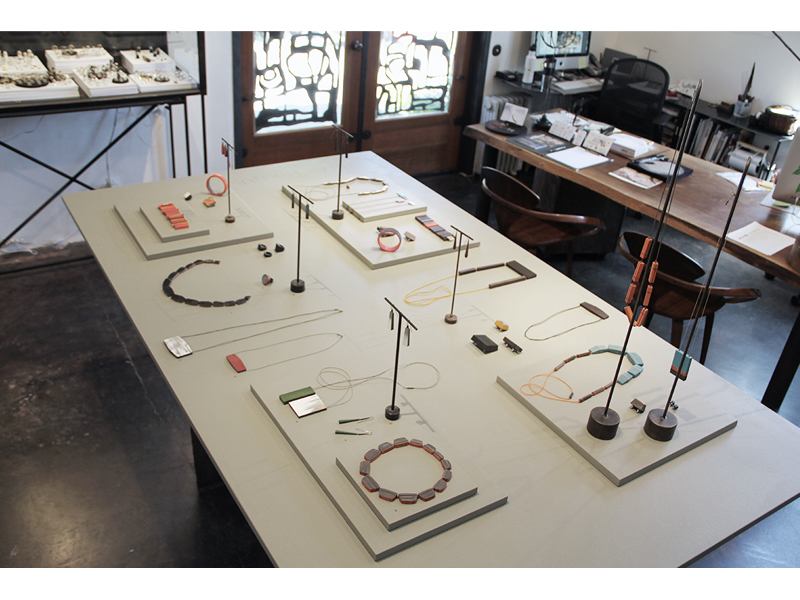
What do you love about representing artists? What do you hate about it?
April Higashi: I love the inflow of new ideas, forms, and the different visions of each artist. And I love to see how different the gallery looks with a new show or by changing artist’s displays.
I hate having to play the role of “mom” and pushing artists to get things here on time. I also feel responsible for sales and making sure I can support the gallery team. That can be daunting.
How do you think the field will develop in the next five years? Any predictions?
I think jewelers will be selling directly to clients more. Clients are getting more comfortable buying online. I wonder if the big craft shows will fade away. They seem to be geared for an older audience. It may take longer than five years, but I don’t see the Millennials going out to these kinds of shows.
Thank you.
